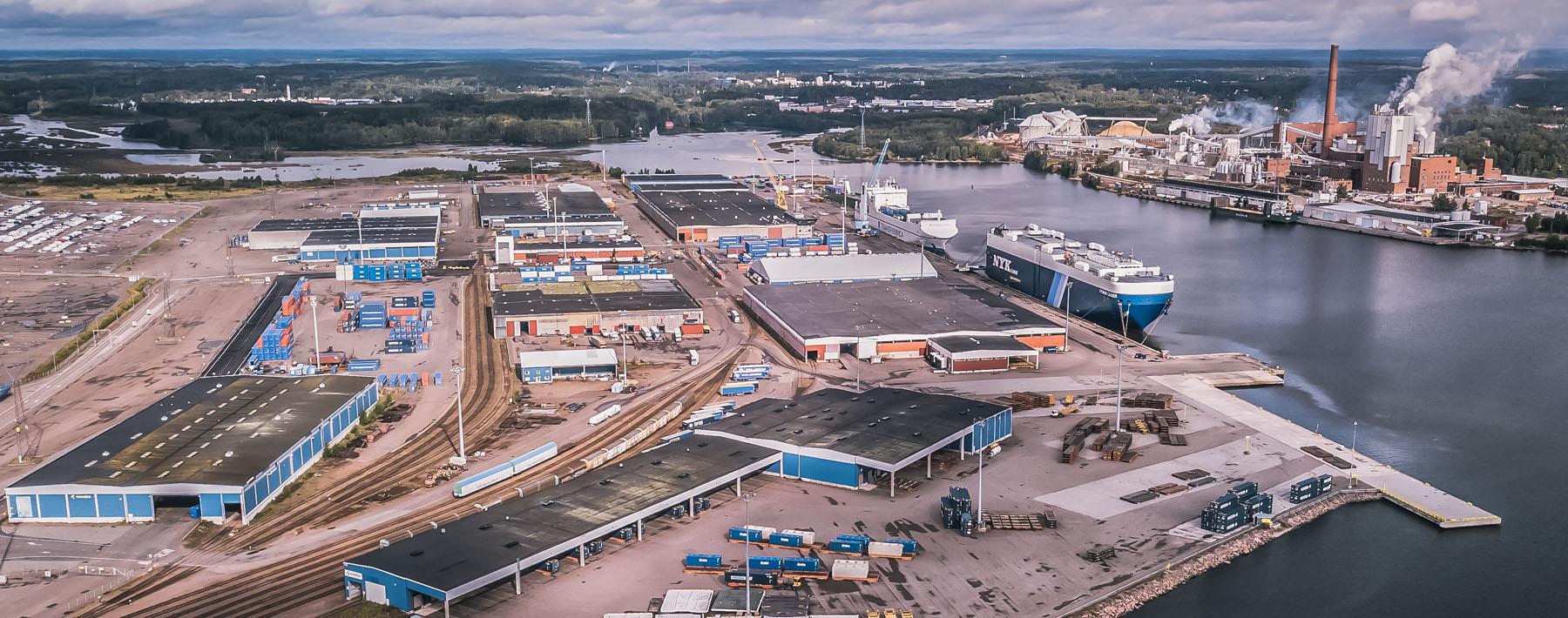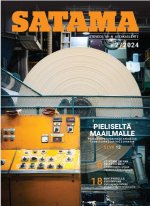Digitalization makes the daily life of the port more efficient

The digitalization of port operations is currently taking big leaps forward. Steveco has many ongoing projects that both streamline the company's own operations and improve customer service.
Steveco is strongly involved in digitalization by developing several parallel information systems. As a result, port operations become more efficient, which is reflected in an even smoother customer service.
One of the most significant new systems is the real-time view of the port, its digital twin. It shows accurately and in real time on the computer screen where each consignment is located at any time, and all information associated with it.
The idea for this system, called VTS (from the Finnish for Warehouse Work Planning), began in 2007 and was properly launched in 2015–2016. The ship load design part was put into operation in 2019 and the warehouse component in September-October 2020. VTS was initially created in the port of Hietanen. In the future, it will also be introduced in other ports, based on the experience gained from Hietanen.
From the big picture to details
Heikki Jääskeläinen, Senior Vice President Development, Steveco, opens a view of the port of Hietanen on the screen and shows how VTS is used.
“Let’s open this warehouse here,” he says as he clicks on a rectangle marked H3 on the screen.
When the warehouse image opens, 10 grey boxes are revealed. They are train wagons not yet unloaded. The yellow and white areas are the pallets on which the loads from the wagons will be unloaded.
"This is the initial input for our supervisors' inventory planning."
When supervisors start planning, they see what loads each wagon contains by clicking on the wagon. Based on this information, they assign work tasks to the forklift drivers.
The first wagon reveals 33 pallets, with tonnage data and ports of destination for each pallet. If a wagon contains only goods going to the same port of destination and on the same ship, a cassette from that shipping company is brought beside the wagon. The forklift driver receives information from the onboard computer that all the pallets of the wagon can be unloaded into one cassette.
“The advantage of VTS is that work planning can take place well in advance. The machine operators see a new task on their cabin display as soon as they move from one warehouse or wagon to another. This new way of working is well suited to Covid times because we avoid close contacts in transferring documents,” says Jääskeläinen.
Ship's secrets revealed
Next, Jääskeläinen shows how work planning with VTS works in a similar way for ships.
The list contains numbers for each cargo unit. For each cargo unit, its location and contents are detailed.
“Based on the list, the supervisor makes a loading sequence order for the machine operators. When the operators select the cassette to be loaded, they mark it in the system and go to retrieve it.”
Supervisors plan the unloading and loading of ships well in advance and are able to control the machine operators remotely. They know who is doing what at any time.
“Here on the left we see the ship’s import cargo and how it is handled. We see that there are four ro-ro units unloaded, but all the containers have been unloaded. On the right side of the screen, we see that there are 118 ro-ro units not yet loaded onboard, 2,089 tonnes of sto-ro cargo and 77 containers to be lifted.”
The whole port on one screen
Besides detailing production planning and work supervision, a major advantage of VTS is the real-time overall picture it gives about what is happening at the port, which used to be impossible.
Looking at the big screen, you are constantly up to date about what is happening: for example, whether rail wagons are empty or full and what the loading status of the ships is. A similar overall picture is obtained for each ship at berth.
More flexible and higher-quality work
Steveco's customers benefit from the VTS system when the work is planned well in advance and runs more flexibly than before. The number of errors is reduced, and the quality of work is improved.
“There are no work interruptions when employees don’t have to ask what to do next. All work assignments are in the computer.”
VTS has been easy to implement, meets Steveco's needs and has been well received by all users, from stevedores to supervisors. This is largely because the system is largely built in-house. It has been defined entirely by Steveco, with an external partner for coding.
Slot allocation brings order to truck traffic
Truck traffic is included in the VTS system. The Truck Appointment System Steveco (TASS) has been built to manage truck arrivals. Its aim is to prevent congestion at unloading sites and the resulting scheduling problems.
“In the TASS system, the haulier reserves time windows for trucks picking up and bringing cargo, according to which they are received and served. We can shorten the time the trucks stay in the port and their turnaround times. Our service improves when we know the arrival times and can better assign resources to unloading,” says Jääskeläinen.
The TASS system behind slot allocation was first trialled at the port of Hietanen in early March. It will be gradually expanded to cover the whole port. Based on experiences gained from Hietanen, the use of slot allocation will be extended to all Steveco terminals.
Steveco's customer haulier does not need to acquire any application to use the slot system. All they have to do is to log in to the online TASS system, pick a terminal there, select the appropriate time window and book it. A message is sent to the driver about the reservation. Once the truck is loaded, the driver opens the application on a mobile phone and acknowledges that the journey has started. When the trucks are on the road, the Steveco terminal can see how they are staying on schedule.
Although there is no direct link from the TASS system to VTS, slot allocation makes unloading planning easier using VTS.
“When we see the schedule of an arriving truck, we can plan the unloading much better in advance and make sure we have the correct unloading equipment reserved.”
For the haulier, slot allocation means faster operation when the unloading equipment is waiting. Unnecessary wait times in the congested unload area of the port are reduced. The change also means that hauliers will have to adapt their operations to the vacant time windows, as the number of unloading bays is limited.
The VTS and TASS systems are just examples of how digitalization is progressing at Steveco.
"We will continue to develop and implement new systems and applications to support service improvement and the cost-effectiveness of our operations," says Jääskeläinen.
Customs declarations are renewed
EU customs legislation will be reformed and, as a result, so will Finnish legislation. This will mean that the preparation of customs declarations will change. The changes will be phased in over the period 2020–2025. The EU Commission will confirm new regulations according to its own schedule.
“The changes will take effect in stages, one customs declaration at a time. Customs warehousing and personal customers' import declarations have already been reformed by the customs authorities. Import declarations for goods released for free circulation have changed in spring 2021,” says Pauliina Lindholm, Head of Logistics, Steveco Logistics.
The changes are not dramatic as customs declarations have been digital for a long time. There will now be some changes to their content, and the preparation of the notifications will change.
“We have modernized our information systems to meet the new requirements, and we are also prepared for changes in the coming years, including exports and transit. We will receive detailed information on the changes from Customs as they come.”
For Steveco's customers, the changes in customs declarations are nearly unnoticeable, as Steveco will take care of the declarations as before. A couple of things, though, should be noted.
“Customers should request an EORI number from Customs, required for goods import declarations. This registration is made on the Customs website."
Another thing customers should take not of is the change in Customs invoicing. This is also detailed on the Customs website.
“We of course help our customers with all these things and advise where to find more information,” Lindholm says.
***
Text: Jukka Nortio
About Author

Satama
SATAMA is our customer magazine. it is published twice a year in Finnish.
